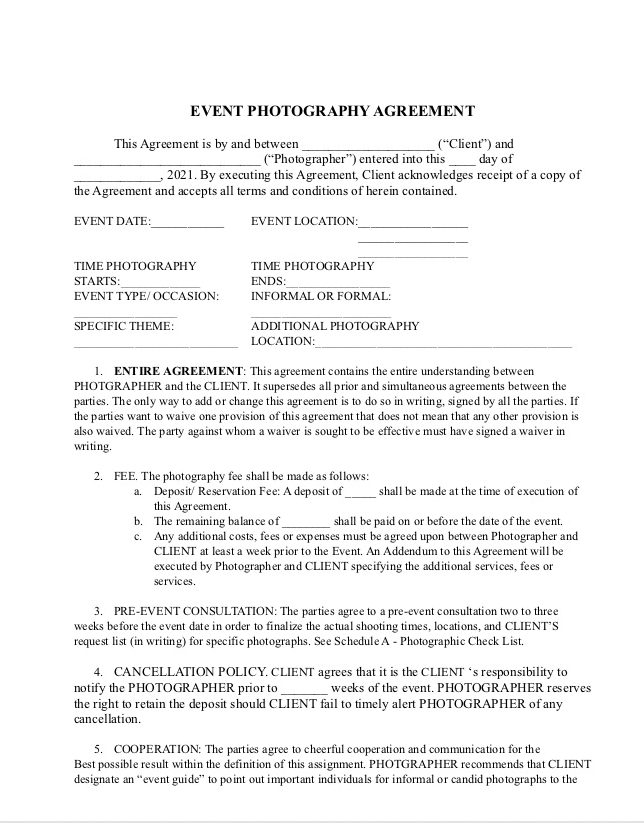Paid photography contracts are the key to a successful photography business. After all, nothing is worse than losing out on money after spending hours or days of work shooting for a client. That’s why you need to make sure that your contract covers everything from timelines and payment schedules to usage rights and image delivery — so both you and your client can be confident that everyone understands their responsibilities under the agreement.
Ready to take the plunge? Here's some advice on how to write an airtight photography contract that helps keep things running smoothly for everyone involved.
What Are The Types Of Photography Contracts?
When both the photographer and client sign a Photography Contract, it becomes legal. This contract ensures that both parties understand the details of photography services being delivered as well as limits any conflicts in the future.

Most photography contracts fall into two categories:
- Work for Hire Contract: The photographer is hired to do a certain project and must deliver the results. All rights to the images are transferred to the employer and the photographer has no control over usage or payment (often called “work for hire”).
- Rights Managed Contract: The photographer retains ownership of their images, but grants specified usage rights to the client. This type of contract typically includes an additional fee for each use granted by the photographer.
Regardless of which type of contract you choose, there are several key clauses that need to be included in order for it to be legally binding. These include details such as timelines and delivery expectations, payment information, usage rights, and more.
No matter the project or client, having a contract in place is essential to protect both parties involved. A well-written photography contract will save you time and headaches down the line — so make sure that yours covers every last detail!
Is a photography contract legally binding?
A photography contract is a professional agreement between the photographer and the client regarding the services rendered. In fact, it is legally binding once both parties sign it. This ensures that all expectations and responsibilities are clear, and protects both the photographer’s interests as well as the client’s.
The most important part of any photography contract is to ensure that it covers all potential scenarios. Detail timelines, payment information, usage rights, model releases (if applicable), even termination clauses — everything should be addressed so that there’s no room for confusion or misunderstanding.
How Do I Write A Photography Contract?
Use these starting tips as a guide for what to include when writing a general photography contract.

The following is the contact information for both the photographer and client: name, address, email, phone. In addition, please also find the start and end times as well as date below. As for payment terms, it includes pricing along with a schedule of payments including deposits or retainers if any. Also mention the extra fees which might include travel expenses, second photographers on site or even permits in some cases.
Next, think of deliverables - what the photographer and client will deliver, and when. The cancellation policy (i.e. what the photographer is responsible for, refund of the deposit, etc.). Image rights (i.e. photo copyright ownership, transfer of usage rights, time period).
A model release waiver should be signed by each person appearing in the photographs. Likewise, the copyright to these images must also be determined and ownership decided upon - typically this will fall to the client who commissioned them. Editing of said images may also be restricted depending on usage rights.
Finally, think of signature blocks. One for each page of the contract and an overall signature block for both the photographer and client.
By laying out these key points, you can ensure that a Photography Contract is legally binding and clear to all parties involved. With a well-crafted contract, everyone can move forward with confidence - that's why it's important to get it right!
How long should a photography contract be?
Normally, it's advised to keep tax documents for no less than 7 years. So, by that logic, you should also hold onto your photography contracts for at least as long – if not longer! That is because most contracts have usage rights that will remain in effect for much longer than 7 years. So make sure yours is written correctly the first time – you don’t want to be stuck with an outdated contract down the road.
How To Sign Online Contract?
Most client management software nowadays contains the ability to create contracts and request signatures digitally. A popular one used by many photographers is called Studio Ninja - it allows clients to make their bookings in an online portal, and read and sign the contract using any device they have handy.
It's less common for photography clients to sign using pen and paper nowadays, but if your business model permits in-person meetings, asking them to sign on the dotted line when you're present is always an option.

An online signature system is more efficient for both parties, and it's probably the preferable solution. Software such as Adobe Acrobat Pro offers a neat e-signature solution which you can easily integrate into your booking process.
Not only is Acrobat Pro a fantastic tool to create and revise PDFs, but it also streamlines online bookings. If you want software that will simplify your work life, Acrobat Pro is worth the investment.
Is There Anything Else I Should Know?
Yes! When considering a photography contract, no matter whether you are a photographer, or a client, always take into account the following:
- Always read and understand the contract in its entirety before signing it.
- Ensure that there is a clear understanding of what is expected from each party - both verbally and in writing.
- Clarify any grey areas to avoid any confusion or disputes down the line.
In summary, a photography contract is an essential document for any job involving photography services. It should be tailored to your specific needs, timelines, and payment details as well as those of your client.
Bottom Line
In conclusion, a photography contract should be tailored to your specific needs and expectations as well as those of your client. It should also include language that clearly delineates usage rights, timelines, and payment details. By having a clear and legally binding agreement in place, both parties can move forward confidently knowing that all expectations are met!
By having such an agreement in place, both parties will feel secure knowing that their expectations are met! And with online resources available for signatures these days, contracts are easy to handle on any device.